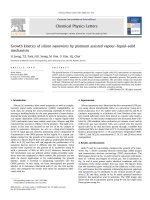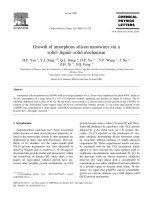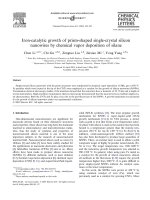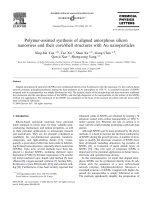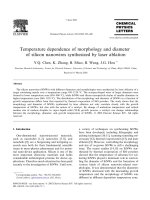- Trang chủ >>
- Khoa Học Tự Nhiên >>
- Vật lý
Synthesis of silicon nanowires after hydrogen radical treatment
Bạn đang xem bản rút gọn của tài liệu. Xem và tải ngay bản đầy đủ của tài liệu tại đây (781.75 KB, 3 trang )
Synthesis of silicon nanowires after hydrogen radical treatment
Minsung Jeon
⁎
, Koichi Kamisako
Department of Electronic and Information Engineering, Tokyo University of Agriculture and Technology, 2-24-16 Nakacho, Koganei, 184-8588 Tokyo, Japan
ABSTRACTARTICLE INFO
Article history:
Received 16 October 2007
Accepted 16 May 2008
Available online 24 May 20 08
Keywords:
Silicon nanowires
Hydrogen radicals
Metal oxide film
Nanoparticles
Silicon nanowires (SiNWs) were synthesized through the hydrogen radical-assisted deposition method.
Voluminous indium (In) metal catalysts with smooth spherical structures were successfully fabricated from
indium oxide films after hydrogen radical treatment for 5 min. Their sizes were widely distributed, ranging
from several nm to about 150 nm. Subsequently, the large quantities of SiNWs were synthesized using the
hydrogen-radical-assisted deposition method. Their diameters typically ranged from several nm to several
hundred nm, and their lengths extended to about 10 μm. The SiNWs were composed of well-crystallized
silicon cores and hydrogenated amorphous outer layers.
© 20 08 Elsevier B.V. All rights reserved.
1. Introduction
Since the initial discovery of carbon nanotubes [1], one-dimen-
sional (1D) nanostructures, including the well-known nanotubes and
nanowires, have been utilized extensively in the various fields of
nanoscale optical and electronic devices [2–5]. In particular, silicon
nanowires (SiNWs) are irresistible materials in the semiconductor
industry because the bulk properties of silicon are well-known.
Several methods, such as the chemical-vapour deposition (CVD)
method and the oxide-assisted, laser ablation, and template-based
techniques, have been proposed for the synthesis of 1D nanostruc-
tures [6–10]. When NWs, however, are synthesized using a vapour–
liquid–solid (VLS ) mechanism [11,12], the sizes of the metal
nanoparticle catalysts have to be controlled because, to a large extent,
the catalyst size determines the growth of NWs. Various methods
have been developed for the fabrication of NWs with metal catalysts,
such as the dispersion of nano-size metal particles, electroless metal
deposition, laser ablation, evaporation, and immobilization of metal
colloidal suspensions [13–16]. In this article, hydrogen radical
treatment was performed on a glass substrate coated with a metal
oxide film to fabricate nano-size particles as catalysts, and their
properties were investigated. In addition, SiNWs were synthesized
through the hydrogen radical-assisted deposition method [17,18], and
their characteristics were analyzed and discussed herein.
2. Experimental
The experimental apparatus that was used in this work was a
stainless-steel chamber equipped with a 1/2-in diameter trumpet-
like quartz discharge tube. A 2.45-GHz microwave was introduced into
the discharge tube through a coaxial cable and a microwave cavity
surrounding the tube. The hydrogen (H
2
) gas was decomposed by
microwave to generate high-d ensity hydrogen ra dicals in the
discharge tube, and hydrogen radicals were released over the sample
surface. To synthesize the SiNWs, silane (SiH
4
) gas was introduced into
the chamber as a Si source from a ring-type tube that had many small
holes, and it was reacted with the microwave afterglow of H
2
in the
discharge tube. This method is referred to herein as the hydrogen
radical-assisted deposition method. The fabrication of the metal
catalysts from a metal oxide film and the synthesis of SiNWs were
performed using this method. Glass substrates coated with an approx-
imately 150 nm thick indium oxide film was used.
To fabricate the indium particles as metal catalysts, the sub-
strates were heated at a temperature of 400 °C in a vacuum chamber
with a pressure of 2 ×10
− 5
Torr. Then the substrate was exposed to
the hydrogen radicals for 5 min with a gas pressure of 0.4 Torr
by introducing H
2
gas with a flow rate of 120 sccm. The indi-
um nanopa rticle catalysts were fabricated after hydrogen radical
treatment. Their properties, crystal phase pattern, and surface mor-
phology were evaluated using an X-ray diffractometer (XRD), with
Cu Kα radiation and field-emission scanning electron microscopy
(FE-SEM).
For synthesizing the SiNWs, SiH
4
gas was introduced as a Si source
after the fabrication of the metal nanoparticles. The gas pressure and
microwave power were set at 0.4 Torr and 40 W, respectively. The
substrate temperature was kept at 400 °C during the growth of the
SiNWs. The H
2
and SiH
4
gas flow rates that were introduced to
synthesize the SiNWs were 130 sccm and 12 sccm, respectively. The
SiNWs were synthesized for 1 h, and their properties were estimated
using XRD measurement and FE-SEM microscopy. For further
investigation, the characteristics of the synthesized SiNWs were
analyzed through selected-area electron diffraction (SAED) and with
Materials Letters 62 (2008) 3903–3905
⁎ Corresponding author. Tel./fax: +81 42 388 7133.
E-mail address: (M. Jeon).
0167-577X/$ – see front matter © 2008 Elsevier B.V. All rights reserved.
doi:10.1016/j.matlet.2008.05.035
Contents lists available at ScienceDirect
Materials Letters
journal homepage: www.elsevier.com/locate/matlet
the use of a transmission electron microscope (TEM) and an energy
dispersive X-ray spectrometer (EDX).
3. Results and discussion
For the fabrication of the metal nanocrystal catalysts, an indium oxide (In
2
O
3
) film
was used as a metal oxide film-coated glass substrate, and its properties were analyzed
through XRD and FE-SEM measurement. Fig. 1 shows the XRD pattern of the metal
oxide film (a) before and (b) after hydrogen radical treatment. The FE-SEM image after
hydrogen radical treatment is shown in Fig. 1(c). The typical XRD peaks of the as-
deposited In
2
O
3
film shown in Fig. 1(a) reveal the high relative intensity of the (222)
peak compared with the other peaks. On the other hand, hydrogen radical treatment
was performed on the substrate for 5 min at 400 °C to fabricate the metal nanocrystal
catalysts. As for the XRD results after hydrogen radical treatment, as shown in Fig. 1(b),
only the crystal indium (In) diffraction peaks of (101), (002), (110), (112), and (200) were
observed. In particular, the indium peak of (101) was strongly revealed. The hydrogen
radicals could react with the metal oxide film on the substrate surface to fabricate the
metal nanocrystal catalysts. As a result, only the metal indium nanocrystals remain on
the substrate after hydrogen radical treatment. To estimate the morphologies of the as-
fabricated indium nanoparticles after hydrogen radical treatment, FE-SEM observation
was performed. Fig. 1(c) shows the large quantity of nano-size indium crystals. The
fabricated nanocrystals are shown as having smooth spherical structures, and their
sizes are shown to range from several nm to 150 nm. Based on the above results, it was
realized that hydrogen radical treatment is an essential process that must be performed
when metal nanocrystal catalysts are fabricated from metal oxide films. After the
fabrication of the indium nanocrystal catalysts, the SiNWs were synthesized using
the hydrogen radical-assisted reaction deposition method for 1 h, at the same temper-
ature. The morphologies of the synthesized SiNWs were observed through FE-SEM
measurement.
Fig. 2 shows the low-magnification top-view FE-SEM micrograph of the as-
synthesized SiNWs. The voluminous quantities of SiNWs were grown for 1 h at 400 °C.
The detailed FE-SEM analysis revealed that the SiNWs were tapered and that the In
catalyst remained on top of the SiNWs (Fig. 2 inset). The as-synthesized SiNWs were
approximately several nm to several hundred nm in diameter, and their lengths
extended to about 10 μm. Furthermore, to confirm the crystal structure of the SiNWs,
TEM analysis was carried out. The results of the high-resolution TEM (HR-TEM) analysis
support the structural distinction made above.
Fig. 3 shows the HR-TEM micrograph and SAED pattern of an as-synthesized SiNW.
The lattice fringes correspond to the (-1-11) and (1-11) planes. The crystalline SiNW was
revealed to be sheathed by an approximately 10 nm-thick amorphous outer layer. The
SAED pattern of one individual SiNW is shown in the inset of Fig. 3. The set of diffraction
spots visible in the SAED pattern reveal that this particular SiNW contains a twin.
Moreover, it can be indexed as the diffraction along the [110] zone axis of crystalline Si,
and it suggests that SiNW growth does occur along the [111] direction.
The TEM micrograph in Fig. 4(a) reveals that the nanocrystal catalysts are located at
the end of the SiNW. The EDX measurement made on the nanoparticles (Fig. 4(b))
indicates that the particle is composed of Si and In. Here, the detected O and Cu are the
effect of the TEM copper grid. The indium nanoparticle located on top of the
synthesized SiNW suggests that an indium catalyst-assisted VLS mechanism is basically
involved in the growth of SiNWs [18]. Fig. 4(c) reveals the EDX measurement of the
Fig. 1. XRD patterns before and after hydrogen radical treatment. (a) Peaks of the as-
deposited indium oxide film as a metal oxide film. (b) Indium peaks after hydrogen
radical treatment for 5 min at 400 °C. (c) FE-SEM image of the as-fabricated indium
nanocrystals as metal catalysts after hydrogen radical treatment.
Fig. 2. Top-view FE-SEM image of the SiNWs. The inset shows a high-magnification
FE-SEM image of the SiNWs.
Fig. 3. HR-TEM micrograph of the as-synthesized SiNW taken along the [110] direction
and the SAED diffraction spots (inset).
3904 M. Jeon, K. Kamisako / Materials Letters 62 (2008) 3903–3905
SiNW stem. The SiNW is composed only of the Si element. These results confirm that
SiNWs are crystalline and that their sheathed outer layer is a hydrogenated amorphous
layer.
4. Conclusion
In this work, the formation of metal catalysts from a metal oxide
film and the synthesis of SiNW were presented using the hydrogen
radical-assisted deposition method. After hydrogen radical treatment
for 5 min at 400 °C, the indium metal catalysts were successfully
fabricated from the indium oxide films. They were shown to have
smooth spherical structures and to have sizes ranging from several nm
to 150 nm. Subsequently, the SiNWs were synthesized, and large
quantities of them were whisker-likely grown. The diameters of the
as-synthesized SiNWs were approximately several nm to several
hundred nm, and their lengths extended to about 10 μm. The SiNW
was crystalline, and it was sheathed with a hydrogenated amorphous
outer layer that was about 10 nm thick. These results suggest that the
hydrogen radical-assisted deposition method, including the radical
pre-treatment process, is a candidate method. Moreover, the results
indicate that a voluminous quantity of SiNWs, not including oxygen,
can be synthesized in a simple way.
References
[1] Iijima S. Nature 1991;354:56.
[2] Alivisatos AP. Science 1996;271:933.
[3] Hu J, Ouyang M, Yang P, Lieber CM. Nature 1999;399:48.
[4] Au FK, Wong KW, Tang YH, Zhang YF, Lee ST. Appl Phys Lett 1999;75:1700.
[5] Cui Y, Lieber CM. Science 2001;291:851.
[6] Westwater J, Gosain DP, Tomiya S, Usui S, Ruda HE. J Vac Sci Technol B 1997;15:554.
[7] Cui Y, Lauhon LJ, Gudiksen MS, Wang J, Lieber CM. Appl Phys Lett 2001;78:2214.
[8] Wang N, Tang YH, Zhang YF, Lee CS, Bello I, Lee ST. Chem Phys Lett 1999;299:237.
[9] Morales AM, Lieber CM. Science 1998;279:208.
[10] Li J, Papadopoulos C, Xu JM. Nature 1999;402:253.
[11] Wagner RS, Ellis WC. Appl Phys Lett 1964;4:89.
[12] Givargizov EI. J Cryst Growth 1975;31:20.
[13] Wu Y, Xiang J, Yang C, Lu W, Lieber CM. Nature 2004;430:61.
[14] Peng K, Yan Y, Gao S, Zhu J. Adv Fun Mater 2003;13:127.
[15] Li C, Fang GJ, Sheng S, Chen ZQ, Wang JB, Ma S, et al. Physica E 2005;30:169.
[16] Hofmann S, Ducati C, Neill RJ, Piscanec S, Geng J, Borkowski RE, et al. J Appl Phys
2003;94:6005.
[17] Nagayoshi H, Yamamoto Y, Kamisako K. Jpn J Appl Phys 1996;35:L451.
[18] Jeon MS, Kamisako K. Appl Surf Sci 2008, doi:10.1016/j.apsusc.2008.01.157.
Fig. 4. (a) TEM micrograph of the SiNW capped by a catalyst nanoparticle. (b) and (c) represent the corresponding EDX spectra taken from the catalyst nanoparticle and SiNW stem
shown in Fig. 4(a).
3905M. Jeon, K. Kamisako / Materials Letters 62 (2008) 3903–3905


